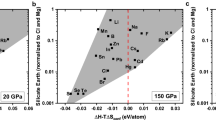Abstract
THE total neutron cross-sections of samples of zirconia and hafnia have been measured between 0.05 eV. and 10 eV. using a crystal spectrometer, and between 0.003 eV. and 0.1 eV. using a mechanical time-of-flight spectrometer.
This is a preview of subscription content, access via your institution
Access options
Subscribe to this journal
Receive 51 print issues and online access
$199.00 per year
only $3.90 per issue
Buy this article
- Purchase on Springer Link
- Instant access to full article PDF
Prices may be subject to local taxes which are calculated during checkout
Similar content being viewed by others
References
Melkonian, Phys. Rev., 76, 1750 (1949).
Havens and Taylor, Nucleonics, 6, 66 (1950).
Colmer and Littler, Proc. Phys. Soc., 63, 1175 (1950).
O.R.N.L., 366.
Harris, et al., Phys. Rev., 80, 342 (1950).
Author information
Authors and Affiliations
Rights and permissions
About this article
Cite this article
EGELSTAFF, P., TAYLOR, B. Slow Neutron Cross-sections of Zirconium and Hafnium. Nature 167, 896–897 (1951). https://doi.org/10.1038/167896a0
Issue Date:
DOI: https://doi.org/10.1038/167896a0
Comments
By submitting a comment you agree to abide by our Terms and Community Guidelines. If you find something abusive or that does not comply with our terms or guidelines please flag it as inappropriate.



